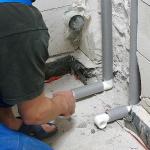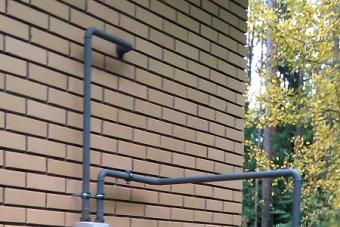Making repairs in the bathroom, many are faced with a very important problem: where to hide the intricacies of pipes, taps, valves that are inevitably present in the toilet? With the help of modern materials, you can easily solve this issue literally in a day or two, even without being a specialist in the field of repair.
How to close the pipes in the toilet with drywall: solutions
Repair in the toilet does not look complete if communications and plumbing are left open. There are several ways to give a neat look to the wall near which the pipes are located, any of which can be easily implemented in a room of any size, which means that they are suitable for even the most compact toilets or combined bathrooms.

We offer you the following options:
- The first way to design the area where the pipes are located is to install blinds. With their help, you can hide the unflattering appearance of the pipes, they do not need to be fastened for a long time, moreover, the blinds are easy to clean. The disadvantage of this design is that the blinds are not very reliable, they can break and then you need to replace them completely.
- The second option for decorating pipes is a communication cabinet. It can be made according to the principle of a conventional cabinet built into the wall, assembled from improvised materials or sized and mounted in a custom niche. The advantage of the cabinet is access to all pipes and valves. In addition, in such a cabinet, you can additionally put shelves for household chemicals or textiles. Unfortunately, cabinets of this kind do not fit into all interiors, and in a small bathroom, along with shelves, they will also take up a lot of space.
- The best option for any design solution is a drywall box in which pipes and a ventilation shaft will be closed. It is easy to make, can be finished in many ways, and the shape of the box can be given, based on the characteristics of the room.
You can close the pipes in the toilet with drywall with a minimum of tools and materials, while spending very little time. We describe this process in more detail below.
How to make a drywall box in the toilet: materials and tools
The first step in designing a bathroom box: choose what size the future design will be. If the bathroom is narrow, and the pipes are located along its short wall, you can sew it up completely to the full width and height.
For a small number of pipes in the lower part of the wall, you can make a parapet box, which along the way will serve as a shelf.
And in a spacious toilet, the box can be effectively disguised as a ledge or column. For the manufacture of the box, one of the most popular materials in modern construction is used - drywall sheets. They are attached to a special profile that can be bought at any hardware store.

For the box you will need:
- Moisture resistant drywall sheet (GKL);
- Profile guides (PN);
- Wall profiles (they are also called rack-mount, PS);
- Dowel-nails 6x60;
- Self-tapping screws for;
- Frog loops for the hatch.
To save space, you can replace wall profiles with dimensions of 50x50 with ceiling PP 60x27, and guides 50x40 with ceiling guides PPN 27x28.
The toolkit for making a drywall box with your own hands will come in handy like this:
- Screwdriver;
- Hammer drill / impact drill;
- Painting knife for;
- Level;
- Metal shears / grinder for cutting profiles;
- Roulette;
- Plumb.
If the issue of saving money is acute, you can replace metal profiles with wooden beams, and drywall with cheaper plastic panels. When all the tools are assembled, and the material is purchased, and the size of the box is determined, you can begin the work on sewing plumbing pipes themselves.
How to close the pipes in the toilet with drywall: step by step instructions
We start with marks on the walls and ceiling, where the profile frame of the future structure will be attached. We expose them with a marking pencil or marker.

- We cut the wall profile with scissors or a grinder and fasten the dowel-nails to the wall in places where the connection with drywall will take place. Separately, we attach profile segments of the same length to the floor - they will serve as a frame for the future box. Align the position of the profile with a level so that it is perpendicular to the floor.
- We cut the PPN guides into pieces equal to the width of the box from the wall to the front wall. We fasten these segments from the end to the floor and ceiling or wall at the height of the box, if it does not close communications from floor to ceiling. We mount a few more of the same segments between the wall and the wall profile as stiffeners of our design.
- Drywall cut into pieces of the desired size. We fasten it to the profile on the sides of the box with self-tapping screws every 5-6 centimeters around the entire perimeter. On the front wall, we need an inspection hole for access to meters, taps and valves. Therefore, before attaching the front wall of the box, mark and cut a hole for the door or hatch. Then, similarly to the side walls, attach to the profile.
The base of our box is ready, now it's time to decorate the door and attach it to the front panel of the structure.
We make out the door for the box in the toilet
The door for the plumbing box can be made from various materials. Here is just a small list of how you can arrange access to communications in the toilet.
Among them are:
- drywall is the easiest and most natural option, especially since you already have a blank for the door;
- wood panel or veneer;
- a small roller blind;
- plastic panel;
The most practical and inconspicuous option is a drywall door. The finished piece of GKL can be lightly sanded around the edges with sandpaper and put on frog loops, which can be bought at any hardware store.
The most popular are the four-hinged frog furniture hinges.
We fasten the hinges with self-tapping screws to the front wall of the box and check whether the resulting door is tightly buried.
How to decorate a pipe box in a toilet
In order for the box that hides the pipes in the toilet to look complete, it must be prepared for finishing, and then finished with suitable materials. Preparation is done in the same way as for any.
Priming will help not only reduce the consumption of putty, but also protect against the appearance of fungus and mold.

We process the box with soil, cover it with several layers of putty, then rub and grind the surface. The edges of the box can be decorated with plastic or metal drywall corners. They can easily be "planted" on the same putty.
As a box finish, you can use:
- Tiled tiles, which finished the bathroom, and the door of the box can also be finished with tiles;
- Moisture resistant wallpaper;
- Water-based paint;
- Wooden or plastic lining.
Try to choose a finish for the box in the same style as the rest of the renovation in the toilet and give preference to materials that are easy to clean and resistant to moisture. Detailed instructions for decorating the walls of the box can be found on the video on the Internet.
Installation of a drywall box in the toilet (video)
A box in a drywall toilet is a very simple design that will reliably hide not too attractive ventilation shafts. You can make it in a room of any size, and a variety of options for boxes and their finishes will allow you to create the most convenient structure that will give access to plumbing communications and look beautiful at the same time.





